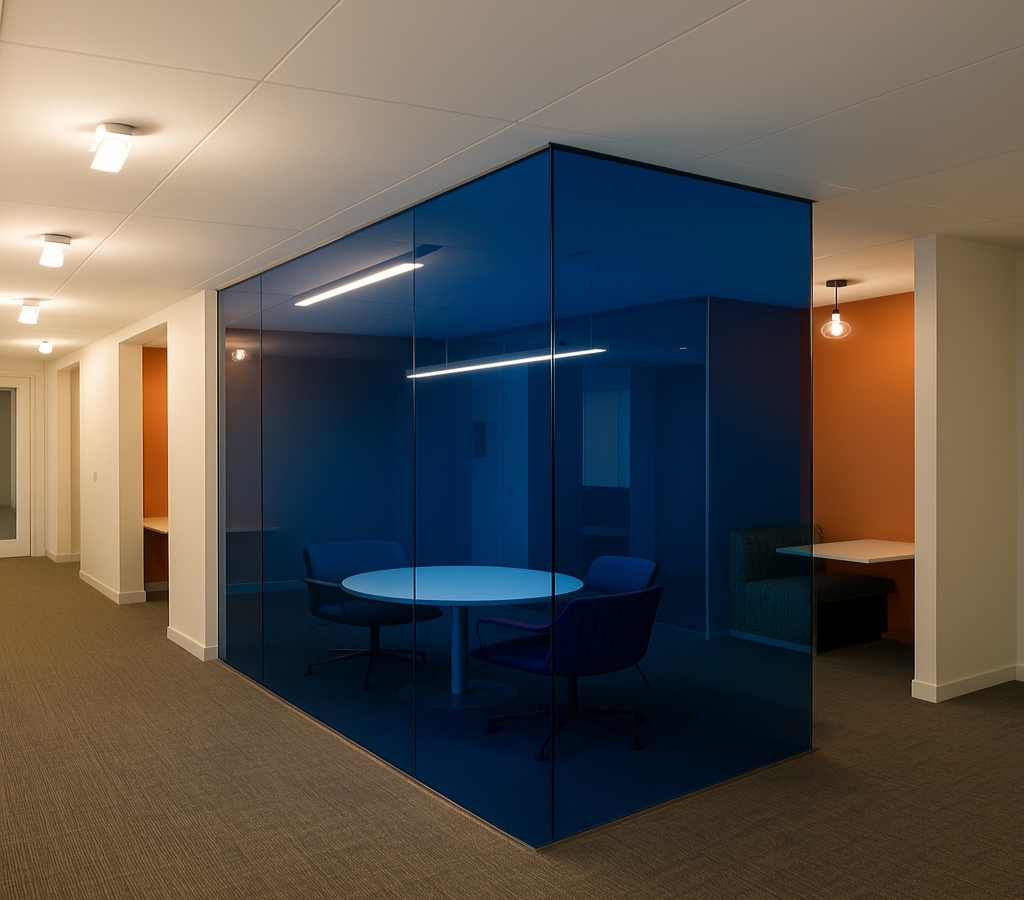 Choosing the right materials for your space can make all the difference in creating an environment that is both functional and visually appealing. One material that has gained significant popularity in modern interior and architectural design is blue-tinted glass. Known for its ability to control glare and its subtle yet striking hue, blue-tinted glass offers a unique touch that can transform any room. Whether you’re outfitting a conference room, manager cabin, or creative studio, this glass can set the tone for your space. But is it the right choice for your project?
Choosing the right materials for your space can make all the difference in creating an environment that is both functional and visually appealing. One material that has gained significant popularity in modern interior and architectural design is blue-tinted glass. Known for its ability to control glare and its subtle yet striking hue, blue-tinted glass offers a unique touch that can transform any room. Whether you’re outfitting a conference room, manager cabin, or creative studio, this glass can set the tone for your space. But is it the right choice for your project?
In this blog, we’ll explore the key advantages of blue-tinted glass, what to consider before integrating it into your design, and how to combine it with other materials to create a space that is both stylish and efficient.
What Makes Blue Tinted Glass Unique?
Blue tinted glass is an architectural glass infused with metal oxides during production, giving it a soft blue hue that enhances both light and space. It gently cools and diffuses natural light, creating a calm, airy atmosphere while reducing glare and filtering harmful UV rays. Unlike other tints, blue offers a uniquely soothing quality, cooler than green, lighter than grey, and more refined than bronze.
Where green tinted glass often blends with natural environments and grey lends a muted, industrial feel, blue stands out for its clarity and quiet elegance. It doesn’t absorb light heavily or make a space feel enclosed. Instead, it elevates interiors with a sense of stillness and sophistication, making it a preferred choice for contemporary spaces that value both beauty and function.
Where Does Blue Tinted Glass Work Best?
Common applications:
1. Glass partitions
Blue tinted glass adds an elevated, polished feel to interior partitions, making them more than just functional dividers. It brings softness to open-plan layouts while still allowing light to flow through. The cool tint subtly defines spaces without the visual weight of solid walls. This makes it ideal for offices, studios, and collaborative environments that need both openness and separation.
2. Interior doors
As part of interior door designs, blue tinted glass introduces a clean, modern touch that complements various architectural styles. It enhances privacy without blocking light, maintaining visual connectivity between rooms. The soft hue lends itself beautifully to calm, minimalist spaces. Whether framed or frameless, it brings a refined finish to everyday transitions.
3. Facades and shopfronts
On external facades and storefronts, blue tinted glass offers a sleek, contemporary aesthetic while providing practical benefits like heat and glare reduction. It reflects the sky and surroundings, giving the building a harmonious, high-end look. The tint helps regulate interior comfort without compromising visibility or branding. It’s a popular choice for retail and commercial spaces seeking elegance and efficiency.
Works especially well in:
1. Coastal areas
In coastal settings, blue tinted glass blends effortlessly with the natural palette of sea and sky. Its reflective quality enhances ocean views while softening harsh sunlight common in seaside locations. It resists fading and heat absorption, offering long-term performance in environments with strong UV exposure. The result is a serene, seamless connection between indoor space and natural surroundings.
2. Minimalist and contemporary interiors
Minimalist and modern designs thrive on clarity, simplicity, and light; and blue tinted glass fits seamlessly into this philosophy. Its gentle tone adds visual interest without clutter, enhancing natural light while maintaining a clean look. It pairs well with neutral palettes, sleek materials, and open layouts. As a design element, it brings subtle character to spaces built on restraint.
Why Do Some Designers Prefer Blue Over Other Tints?
1. Creates a calming atmosphere
Blue tinted glass brings a sense of stillness and ease to a room, making it ideal for spaces that benefit from a serene, focused mood. Its cool tone lowers visual noise and supports restful environments. In wellness centres and modern offices, creating a peaceful, intentional space. Designers use it to subtly guide how a room feels.
2. Enhances natural light
This glass softens sunlight, reducing glare while keeping interiors bright and open. It interacts beautifully with white walls and neutral tones, amplifying clarity without overwhelming the palette. In minimalist spaces, it becomes part of the architecture without distraction. Its relationship with light is one of its strongest design assets.
3. Feels premium and understated
Blue tinted glass adds sophistication without shouting for attention. It delivers a refined finish that speaks to quality and intention. Unlike more dramatic tints, it complements rather than competes with other materials. It’s a quiet luxury that designers trust to elevate a space with subtle impact.
How Does Blue Tinted Glass Compare to Other Types?
Each tinted glass option brings its own unique character and performance qualities to a space. Below is a breakdown of how it compares across key factors:
| Aspect | Blue-tinted glass | Green-tinted glass | Bronze-tinted glass | Grey-tinted glass |
|---|---|---|---|---|
| Heat control | Provides moderate heat control by reducing solar heat, making interiors cooler in hot climates. | Offers a balanced reduction in heat, suitable for temperate climates. | Excellent at heat absorption, keeping interiors cooler in hot climates. | Highly effective in controlling heat, making spaces cooler in sunny areas. |
| Aesthetic value | Offers a modern, cool look, ideal for contemporary designs. | Provides a natural, calming tone that blends well with greenery. | Adds warmth and richness, creating an elegant and cozy atmosphere. | Provides a neutral, professional look, complementing various designs. |
| Privacy | Higher privacy due to its darker shade, reducing visibility from outside. | Moderate privacy; the lighter tint allows more visibility. | High privacy, with a reflective nature that conceals interiors well. | Offers decent privacy, balancing visibility with natural light. |
| Light transmission | Reduces light transmission, creating a cooler, shaded interior. | Allows more light while offering a softer, natural lighting effect. | Significantly reduces light, darkening interiors but cutting glare. | Moderately reduces light, providing a balanced lighting environment. |
Can Blue Tinted Glass Work in Office Partitions?
Yes, blue-tinted glass can work effectively in office partitions, especially in the following areas:
1. Conference rooms
Blue-tinted glass contributes to a calm, focused atmosphere that is ideal for meetings and discussions. It helps minimize glare from screens and direct sunlight, making it a practical choice for spaces with a lot of light exposure.
2. Manager cabins
In manager cabins, blue-tinted glass strikes the right balance between privacy and openness. It allows natural light to filter in while maintaining a sense of separation from the rest of the office.
3. Creative studios
The calming blue hue of the glass encourages concentration and creativity, providing an ideal environment for innovation. It also reduces distractions outside, letting natural light flow in without overwhelming the space.
4. Frameless glass systems and aluminium frames
When paired with frameless glass systems or aluminium frames, blue-tinted glass enhances a minimalist design, contributing to a clean and contemporary look. The subtle tint adds depth and style to the office partitions, making them stand out.
5. Complementary options
Sliding glass doors provide versatility, allowing spaces to be divided or opened up as needed, all while enhancing the overall design with a modern touch. Switchable glass gives the ability to shift between transparent and opaque states instantly, adapting to changing privacy or light requirements. Frosted zones can be integrated to control transparency in specific areas, offering a balanced approach to light management and spatial division.
What Should You Know Before Choosing It?
Before choosing blue-tinted glass, it’s important to evaluate the following aspects:
1. Lighting and reflection
The blue tint interacts with different lighting conditions, creating a cooler, calming effect in rooms with abundant natural light. However, under artificial lighting, it can introduce a slight color shift, so it’s essential to consider how the space is lit throughout the day to ensure it complements the design.
2. Glass thickness and finish
Glass thickness affects not only the strength and insulation properties of the glass but also the acoustic performance. A thicker pane can help reduce sound transmission, which may be beneficial in office settings. The finish, such as glossy or matte, can change the way the tint appears, influencing both the aesthetic and functionality of the glass, especially in high-traffic areas where scratches are a concern.
3. Cleaning, maintenance, and privacy considerations
While blue-tinted glass offers a modern look, its reflective nature can make it more prone to showing streaks or fingerprints. Regular maintenance is key to keeping its appearance intact, especially in areas prone to dust or water spots. Additionally, while it provides some level of obscurity, it doesn’t offer total privacy at night when the interior is lit, consider supplementary window treatments if privacy is a priority.
What Other Elements Can You Combine Blue Tinted Glass With?
Blue-tinted glass can be combined with a variety of materials and design elements to enhance its functionality and style:
1. Aluminium frames or black steel profiles: Pairing blue-tinted glass with sleek aluminium frames or bold black steel profiles creates a modern, industrial look. This combination not only reinforces the glass’s aesthetic appeal but also adds structural strength to the partitions.
2. Glass wall cladding, partition doors, and double-glazing systems: Using blue-tinted glass in glass wall cladding or partition doors creates a seamless, cohesive design throughout the space. When integrated with double-glazing systems, it enhances insulation properties, making it ideal for energy-efficient office environments.
3. Fluted glass and back-painted glass: Blending blue-tinted glass with fluted glass introduces texture and depth, adding visual interest to partitions and doors. Incorporating back-painted glass can bring a pop of color or subtle contrast, enriching the overall design while maintaining a modern, clean look.
FAQs
Yes, blue tinted glass reduces UV penetration, helping protect interiors and reduce glare.
Absolutely. It works well in both residential and commercial spaces, especially where a clean, calming look is desired.
Yes. It’s popular in facades, especially for buildings looking to reduce heat gain and add a modern look.
It softens bright sunlight while maintaining visibility and a cool, relaxing ambiance.
Yes, like other architectural glass types, it can be processed for safety and strength.














